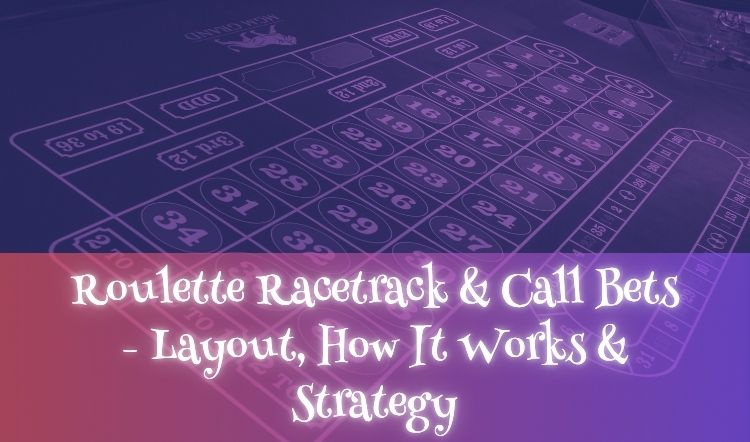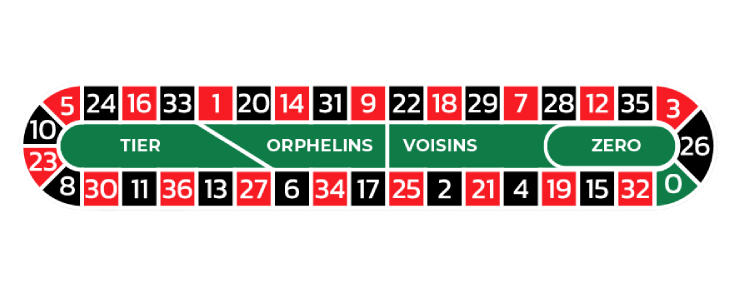
Roulette is widely regarded as a straightforward and accessible game, but for those new to the table, the layout—particularly the racetrack section—can appear a little confusing at first glance. The combination of numbers and betting options might even seem overwhelming for first-time players.
However, the racetrack is designed to make placing certain types of bets easier and more intuitive. In this guide, we’ll break down what the racetrack is, how it works, and how it relates to call bets—a specific category of wagers used in roulette.
Read on to learn more.
What Is The Racetrack In Roulette?
The racetrack is an oval-shaped section typically found above the main betting area on a roulette table. It’s designed to make placing certain group bets quicker and more straightforward, especially when covering specific sets of numbers that appear together on the wheel. These types of bets are known as call bets or announced bets, which we’ll explore in more detail shortly.
The racetrack is most commonly seen in French and European versions of roulette, and it tends to appear more often in online casinos than in land-based venues. That said, some physical casino tables do include it, particularly in regions where these bet types are more popular.
Traditionally, call bets are typically made verbally in land-based casinos, which can make the racetrack layout somewhat redundant in those settings. However, some players prefer using the racetrack visually rather than announcing their bets out loud. It gets its name from its shape, which resembles a racecourse, and its layout mirrors the number sequence found on the roulette wheel itself.
Roulette Racetrack Layout
The roulette racetrack sits alongside the main betting layout and is designed to reflect the number order found on the actual roulette wheel. It resembles an elongated version of the wheel, displaying numbers from 0 to 36 in the same sequence.
This part of the table is divided into four key sections: Tiers, Orphelins, Voisins du Zéro, and Jeu Zéro. Each of these covers a specific group of numbers and is used for placing call bets more efficiently. The racetrack layout helps players quickly select these groupings without having to place individual chips on each number.

What Are Call Bets In Roulette?
In roulette, players typically place their chips directly on the numbers or sections they wish to bet on. However, there is another way to place bets—by verbally announcing the numbers or specific sections they want to cover.
These wagers are known as call bets or announced bets. In some regions, they may also be referred to as French bets or section bets. This method allows players to quickly place bets on predefined groups of numbers, often using the racetrack layout for easier selection.
What Bets Can Be Placed Using The Racetrack In Roulette?
As mentioned earlier, the racetrack is specifically designed for call bets. There are four main types of bets that players can place using the racetrack layout: Jeu Zéro (or Zero), Le Tiers du Cylindre (commonly called Tiers), Orphelins, and Voisins du Zéro (often shortened to Voisins).
In the following sections, we’ll take a closer look at each of these bet types to help clarify how they work and what numbers they cover.
Zero or Jeu Zero
The Zero, or Jeu Zéro, is a specific type of call bet that may not be available at every casino. It’s essentially a smaller section of the larger Voisins du Zéro bet. This wager covers the numbers closest to zero on the wheel, including 12, 35, 3, 26, 0, 32, and 15.
When placing this bet, players typically stake four units. The potential payouts vary, with some numbers offering 17 to 1 and others 35 to 1. Most of the numbers are covered by split bets, which typically pay out at 17 to 1, while the number 26 is covered as a straight-up bet, which typically pays out at 35 to 1.
Le Tiers du Cylindre or Tier
Le Tiers du Cylindre, often simply called Tier, translates to “Thirds of the Wheel” and is a call bet covering 12 numbers on the roulette wheel. These numbers include 27, 13, 36, 11, 30, 8, 23, 10, 5, 24, 16, and 33.
When placing this bet, the wager is divided across six pairs of numbers, with each split bet costing one unit. For example, if a player bets £2 per pair, the total stake would be £12. Since all bets are split bets, any winning pair tends to pay out at 17 to 1.
Orphelins
The Orphelins, or Orphans, cover the numbers on the wheel that aren’t included in the Jeu Zéro, Le Tiers du Cylindre, or Voisins du Zéro bets. These numbers are 1, 6, 9, 14, 17, 20, 31, and 34.
Similar to the Zero bet, the Orphelins include one straight-up bet, with the remaining bets placed as splits. This means the potential payouts are typically either 17 to 1 for the split bets or 35 to 1 for the straight bet.
Voisins du Zero or Voisins
The Voisins du Zéro, often shortened to Voisins, translates as “Neighbours of Zero.” This bet covers zero and the numbers surrounding it on the roulette racetrack.
Instead of placing single bets on each number, Voisins du Zéro combines split bets, a three-number bet (not a street bet), and a corner bet (which covers four numbers adjacent on the layout). Altogether, this bet covers 17 numbers but requires just nine units to stake.
Here’s how a typical Voisins du Zéro wager might be divided, with the corresponding number of units and potential payouts:
-
0, 2 & 3—2 units—typically pays 11 to 1
-
4 & 7—1 unit—typically pays 17 to 1
-
12 & 15—1 unit—typically pays 17 to 1
-
18 & 21—1 unit—typically pays 17 to 1
-
19 & 22—1 unit—typically pays 17 to 1
-
25, 26, 28 & 29—2 units—typically pays 8 to 1
-
32 & 35—1 unit—typically pays 17 to 1
This combination allows players to cover a large section of the wheel efficiently, focusing on the numbers near zero.
Roulette Racetrack Strategy
When it comes to roulette, it’s important to remember that there is no strategy that can guarantee a win. Roulette is a game of chance, and although some players use the racetrack to place bets, it doesn’t influence the outcome of the game.
Like all casino games, roulette carries a house edge, which means the casino has a built-in advantage and will come out ahead over time.
While placing bets on multiple numbers at once may increase the chances of winning, it also means any potential payouts will be smaller, and there is still no certainty of success.
With this in mind, you should always approach roulette responsibly, only wagering money you are comfortable with losing. It’s best to see roulette and other casino games as a form of entertainment rather than a way to try to make money.
*All values (Bet Levels, Maximum Wins, etc.) mentioned in relation to this game are subject to change at any time. Game features mentioned may not be available in some jurisdictions.
**The information provided in this blog is intended for educational purposes and should not be construed as betting advice or a guarantee of success. Always gamble responsibly.
